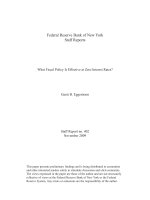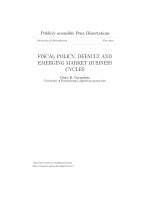37 fiscal policy Macroeconomic
Bạn đang xem bản rút gọn của tài liệu. Xem và tải ngay bản đầy đủ của tài liệu tại đây (412.7 KB, 4 trang )
Context
37
Aggregate Demand
and Fiscal Policy
• The previous chapter introduced the model of
aggregate demand and aggregate supply.
• Long run
• prices flexible
• output determined by factors of production &
technology
• unemployment equals its natural rate
• Short run
• prices fixed
• output determined by aggregate demand
• unemployment is negatively related to output
Bài gi ng c a TS Ph m Th Anh
Copyright © 2004 South-Western
Copyright © 2004 South-Western
Context
The Keynesian Cross
• A simple closed economy model in which
income is determined by expenditure.
• This chapter develops the Keynesian Cross
model, the theory that focus on the role of
government in influencing output and
employment.
(due to J.M. Keynes)
• Notation:
• We focus on the short run and assume the price
level is fixed.
I = planned investment
E = C + I + G = planned expenditure
Y = real GDP = actual expenditure
• Difference between actual & planned
expenditure: unplanned inventory investment
Copyright © 2004 South-Western
Elements of the Keynesian Cross
=
Copyright © 2004 South-Western
Graphing planned expenditure
−
=
planned
expenditure
=
=
=
−
+
+
=
=
1
MPC
income, output,
Copyright © 2004 South-Western
Copyright © 2004 South-Western
1
Graphing the equilibrium condition
The equilibrium value of income
planned
expenditure
planned
expenditure
45º
income, output,
income, output,
Equilibrium
income
Copyright © 2004 South-Western
Copyright © 2004 South-Western
Solving for ∆Y
An increase in government purchases
=
At ,
there is now an
unplanned drop
in inventory…
∆
+
= ∆
=
+
+∆
∆
+∆
+ ∆
= ! "× ∆
∆
"
…so firms
increase output,
and income
rises toward a
new equilibrium
%
∆
# − ! "$
×∆
%
+ ∆
%∆
%
∆
∆
&
∆
=∆
=
−!"
Copyright © 2004 South-Western
The government purchases multiplier
=
=
∆
−!"
− ()
∆
=
×∆
Copyright © 2004 South-Western
The government purchases multiplier
Definition: the increase in income resulting
from a $1 increase in G.
In this model, the G multiplier equals
Example: MPC = 0.8
∆
! "∆
(
∆
∆
∆
= '∆
The increase in G causes income to increase
by 5 times as much!
Copyright © 2004 South-Western
=
−!"
In the example with MPC = 0.8,
∆
∆
=
− (*
)
= '
Copyright © 2004 South-Western
2
Why the multiplier is greater than 1
• Initially, the increase in G causes an equal increase
in Y: ∆Y = ∆G.
• But ↑Y
↑C
further ↑Y
further ↑C
further ↑Y
• So the final impact on income is much bigger than
the initial ∆G.
An increase in taxes
Initially, the tax
increase reduces
consumption, and
therefore E:
∆
At , there is now
an unplanned
inventory buildup…
−! "∆
…so firms
reduce output,
and income
falls toward a
new equilibrium
∆
Copyright © 2004 South-Western
Copyright © 2004 South-Western
Solving for ∆Y
∆
= ∆
+∆
The Tax Multiplier
def: the change in income resulting from
a $1 increase in T :
+
%
+∆
= ∆
= ! "× ( ∆
,
&
∆
−∆
∆
∆
)
# − ! "$
×∆
∆
=
= − ! "× ∆
−!"
×∆
−!"
=
−! "
−!"
If MPC = 0.8, then the tax multiplier equals
∆
∆
=
− ()
− ()
=
= −− ()
(
Copyright © 2004 South-Western
The Tax Multiplier
Copyright © 2004 South-Western
The Tax Multiplier
…is negative:
A tax hike reduces
consumer spending,
which reduces income.
…is greater than one
(in absolute value):
A change in taxes has a
multiplier effect on income.
…is smaller than the govt spending multiplier:
Consumers save the fraction (1-MPC) of a tax cut,
so the initial boost in spending from a tax cut is
smaller than from an equal increase in G.
Copyright © 2004 South-Western
…is negative:
An increase in taxes reduces consumer spending,
which reduces equilibrium income.
…is greater than one (in absolute value):
A change in taxes has a multiplier effect on
income.
…is smaller than the govt spending multiplier:
Consumers save the fraction (1-MPC) of a tax
cut, so the initial boost in spending from a tax
cut is smaller than from an equal increase in G.
Copyright © 2004 South-Western
3
K t lu n
Exercise:
• Use a graph of the Keynesian Cross
to show the impact of an increase in
investment on the equilibrium level of
income/output.
1. Keynesian Cross
basic model of income determination
takes fiscal policy & investment as
exogenous
fiscal policy has a multiplied impact on
income.
Copyright © 2004 South-Western
Copyright © 2004 South-Western
4









